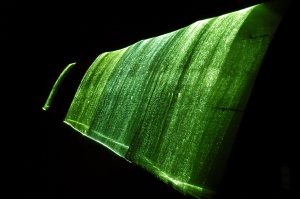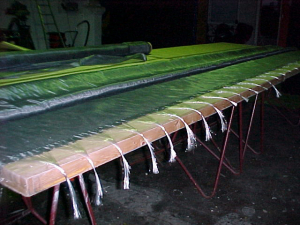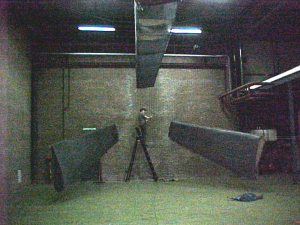Canon
Refers to the identity of cannon sounds and accentuates the acoustic source visually
2004 (7’26”)
Sound Collage
In polyphonic European music canon represents a set technique of strict imitation, in which at least one voice follows another in its melodic or rhythmic identity. In Canon this principle is visualized in the context of the spaciousness of the sound. The word canon also reminds one of the word cannon (here loudspeaker cannon), which catapults sounds into the ether.
Sound:
Two large loudspeakers, which are placed in a wedge-shaped box, shoot rhythmic pulses, which are different in tone quality, into the TEDECO hall. The hall is the resonant chamber, which provides the percussive sounds with reverb and/or echo. Thus a time delay emerges, which is a space dependent constant in relation to the original acoustic source. The TEDECO hall possesses its own characteristic acoustics. First the reverberation of this large hall was measured and the relevant results were reconstructed using a synthetic reverberation (convolution). In Canon you can hear the actual and the synthetic reverberation as well as the different combinations.
Picture:
Simultaneously with the music a three-channel picture composition can be seen, which was made especially for the hall in Deventer.
Three wing-shaped objects made of steel and wood hang from the ceiling, each with a length of 5 meters. The forms of the object are derived from aerodynamics and ballistics and point towards an imaginary target resembling the nuclear symbol.
The objects are covered with a special dark grey fabric, which is manufactured by the Italian company Luminex. This material contains polymer wires.
Depending on the number of wires per bundle light beams of a different width can be seen. Each object possesses 24 bundles (2 octaves). These bundles are connected to small lamps (LEDs), which are controlled by means of MIDI code. The bundles and the lamps are hidden in the objects. The illuminated bundles are used to create visual sound beams, which associatively imitate the rhythmic pulses (canon principle). Each object shines in another color (yellow, orange, green).
Technology:
– plays the percussive composition (hard disk recording)
– translates the visual composition into MIDI data, which is transmitted with a special device to the LEDs
– distributes the visual sound patterns to the three wing-shaped objects
‘Canon’ makes acoustic visible
‘Canon’ refers to the identity of a sound and accentuates the acoustic source visually
‘Canon’ refers to the architectural conditions of a space and sharpens our perception
‘Canon’ plays with space and time




